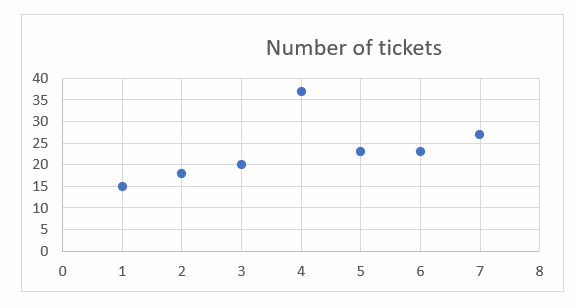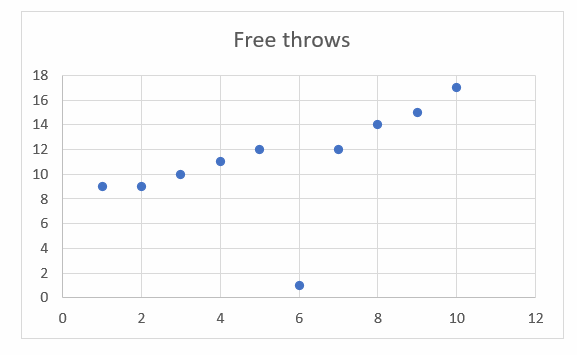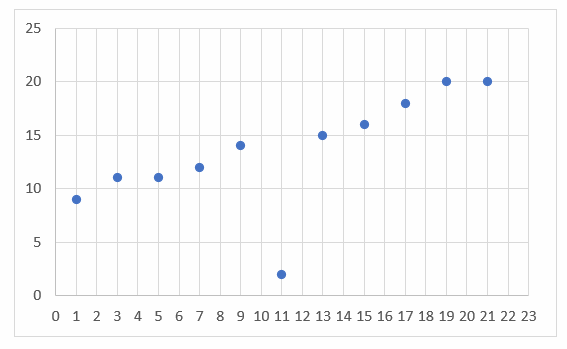How to graph Scatter Plots? (+FREE Worksheet!)
This article teaches you how to graph Scatter Plots in a few simple steps.

Related Topics
- How to Find Mean, Median, Mode, and Range of the Given Data
- How to Interpret Pie Graphs
- How to Solve Probability Problems
- How to Solve Permutations and Combinations
- How to Interpret Histogram
Step by step guide to graph Scatter Plots
A scatter plot is a diagram with points to represent the relationship between two variables.
Data scattering, data distribution, and their range can be observed based on scatter plots. scatter plots are not for observing data details; Rather, it Displays a set of relationships between data.
On a scatter plot, you can use a trend line to make predictions. The scatter of points from the trend line shows how well the data has performed in the predicted pattern.
A scatter plot shows a positive trend if \(y\) tends to increase as \(x\) increases.
A scatter plot shows a negative trend if \(y\) tends to decrease as \(x\) increases.
An outlier is an extreme point in a data set that is separated from all other points.
Scatter Plots – Example 1:
The following table shows the number of people in a family and the amount of money they spend on movie tickets.
| Number of people | 1 | 2 | 3 | 4 | 5 | 6 | 7 | 8 |
| Money ($) | 15 | 18 | 20 | 37 | 23 | 23 | 27 | 28 |
a) Make a scatter plot to represent the data.
b) Does this scatter plot shows a positive trend, a negative trend, or no trend?
c) Find the outlier on the scatter plot.
Solution:
a) Write the ordered pairs. The number of people goes on the \(x\)-axis, so put the number of people first. The amount of money goes on the \(y\)-axis, so put the amount of money second.\((1, 15), (2, 18), (3, 20), (4, 37), (5, 23), (6, 23), (7, 27), (8, 28)\) . Now, graph the ordered pairs.
b) \(y\) tends to increase as \(x\) increases. So, this scatters plot shows a positive trend.
c) \( (4, 37)\) is the outlier because this point is separated from all other points in the data set.

Scatter Plots – Example 2:
The table below shows the number of students on a basketball team and the number of free throws each student made during practice.
| student | 1 | 2 | 3 | 4 | 5 | 6 | 7 | 8 | 9 | 10 |
| Free throws | 9 | 9 | 10 | 11 | 12 | 1 | 12 | 14 | 15 | 17 |
a) Make a scatter plot to represent the data.
b) Does this scatter plot shows a positive trend, a negative trend, or no trend?
C)Find the outlier on the scatter plot.
Solution:
a) Write the ordered pairs. The number of students goes on the \(x\)-axis, so put the number of people first. The number of free throws goes on the \(y\)-axis, so put the number of free throws second.\((1, 9), (2, 9), (3, 10), (4, 11), (5, 12), (6, 1), (7, 12), (8, 14), (9, 15), (10, 17)\). Now, graph the ordered pairs.

b)\(y\) tends to increase as \(x\) increases. So, this scatters plot shows a positive trend.
C) \( (6, 1)\) is the outlier because this point is separated from all other points in the data set.
Exercises for graphing Scatter Plots
Use the given data to make a scatter plot. Does this scatter plot represents a positive trend, a negative trend, or no trend? Find the outlier on the scatter plot.
| x | 1 | 3 | 5 | 7 | 9 | 11 | 13 | 15 | 17 | 19 | 21 |
| y | 9 | 11 | 11 | 12 | 14 | 2 | 15 | 16 | 18 | 20 | 20 |

First, find the ordered pairs.\((1, 9), (3, 11), (5, 11), (7, 12), (9, 14), (11, 2), (13, 15), (15, 16), (17, 18), (19, 20), (21, 20)\) . Now, graph the ordered pairs. \(y\) tends to increase as \(x\) increases. So, this scatters plot represents a positive trend. An outlier is a point that is separated from all other points. So, point \((11, 2)\) is the outlier.

Related to This Article
More math articles
- 4th Grade IAR Math Worksheets: FREE & Printable
- FREE ATI TEAS 7 Math Practice Test
- How to Solve Multi-step Word Problems for Finding Starting and Ending Times
- Top 10 SHSAT Prep Books (Our 2023 Favorite Picks)
- Amounts of Money Comparison
- Top 10 Math Books for Grade 7 Students: A Complete Review
- 10 Most Common 6th Grade ACT Aspire Math Questions
- How to Find Probability of an Event? (+FREE Worksheet!)
- How to Graph Transformation on the Coordinate Plane: Rotation?
- PSAT Math Practice Test Questions

















What people say about "How to graph Scatter Plots? (+FREE Worksheet!) - Effortless Math: We Help Students Learn to LOVE Mathematics"?
No one replied yet.